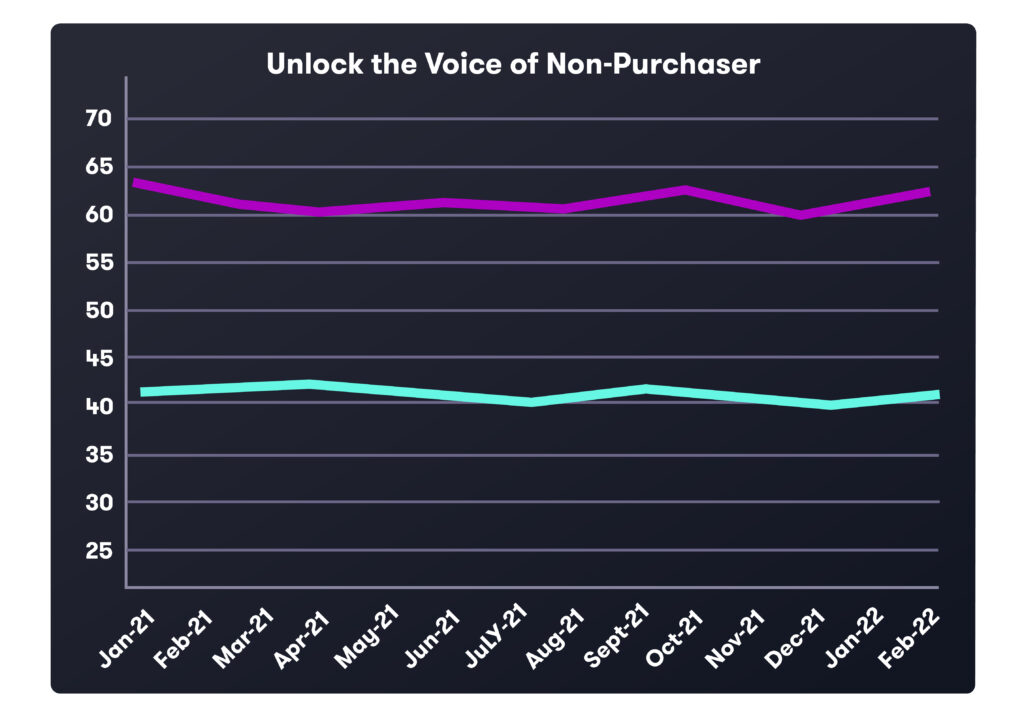BLOG
62% of Non-Purchasers intend to buy, so why are retailers not converting more store traffic?
by Zack Hamilton

Retailers are facing the same challenge today as they have for the last 20 years or more: converting in-store traffic. Marketing teams have launched a variety of conversion initiatives, including coupons, marketing promotions, increasing dwell times, and strategic pricing strategies. All have the ability to increase sales for a short period of time, but have not consistently improved store traffic conversion.
Market research studies have been conducted to explore how a brand can entice the customer to make a purchase. CMOs have also launched consumer panels to understand why customers visit their stores, browse through the merchandise, but walk out without purchasing. Countless hours have been spent analyzing transactional data and customer feedback from purchasers trying to find the answers to these questions.
Many brands’ strategies focus solely on purchasers. What can we learn from our purchasers’ experiences? How do we improve the purchaser’s experience in hopes of increasing in-store conversions? These are great questions to ask and solve, but there is a significant distinction between a customer who purchases and a customer who does not – the quality of their in-store experience!
The key to unlocking the non-purchaser is understanding WHY they visited the store and did not make a purchase.

(This data represents more than 15 North American retail brands including more than 1M unique customer engagements)
Retailers have turned to unlocking the non-purchaser as a key growth strategy. With the advancement of in-store technology, as well as customer adaptation to digital technologies on their smartphones, engaging with the non-purchaser has become a less complex process.
The non-purchaser feedback above shows a significant experience gap, but brands aren‘t necessarily understanding WHY customers are visiting their stores without making a purchase. The missing experience data is leading to operational execution efficiencies, pivots in strategy, and holistic CX strategies built by executive leaders who are powered by actionable data.
62% of non-purchasers had the intention to make a purchase while in-store.
At Chatter, we have elevated our retailer growth strategies by communicating with non-purchasers and enabling brands to automate digital conversion. In doing this, we have been able to help brands understand their in-store experience gap while saving lost sales in real -time. Our conversational AI understands customer intentions by analyzing their feedback, then automates a digitally enabled “save the sale” closed-loop action. On average, our “save the sale” feature has converted an additional $1,200 in incremental revenue per store per month.
So, why aren’t other customers experience SaaS technologies unlocking the same results for their retail brands?
There are two reasons why Chatter is a leader in this space versus other players.
1.) Competitors have only been focused on the purchaser. Their customer engagement strategies for feedback rely on traditional methods like email surveys, and have not leveraged new digital capabilities to connect with shoppers outside of this segment.
2.) Traditional experience management technologies still rely on manual actions to close the loop. A LinkedIn poll shared with my network of customer experience professionals (3k+) revealed 60% of brands are relying on human actions while 40% are not taking action at all.
Chatter’s “save the sale” solution uses innovative digital technologies to connect and understand why non-purchasers did not convert on their purchasing intentions. In real time, our conversational AI engages with customers to understand their experiences versus relying on a traditional survey that is only sent out after the fact. As a result, it can collect insights and offer suggestions while non-purchasers still have the brand top of mind, effectively closing the loop and converting them into buyers.
Click here to download a case study on how a global retailer increased in-store conversions by 5%.
Not only did the retailer meet their original goal of increasing store traffic conversions, but they also increased the level of trust between them and their customers. How? Trust is built on every store visit when a customer can find what they are looking for, receive help from an employee, and enjoy the ease and convenience of accomplishing their original purchasing intent.
If you’re not speaking to non-purchasers, you’re missing out on a golden opportunity. No modern CX toolkit is complete without a “save the sale” strategy in place.
Chat with Zack! text XM to 20404 and share your biggest take-away from this blog.
Want to Chat some more? Click Here to schedule a 30-minute session with Zack.
Connect with Zack for a chat
Zack Hamilton
Senior Vice President, Chief Experience & Strategy
![]()
![]()
